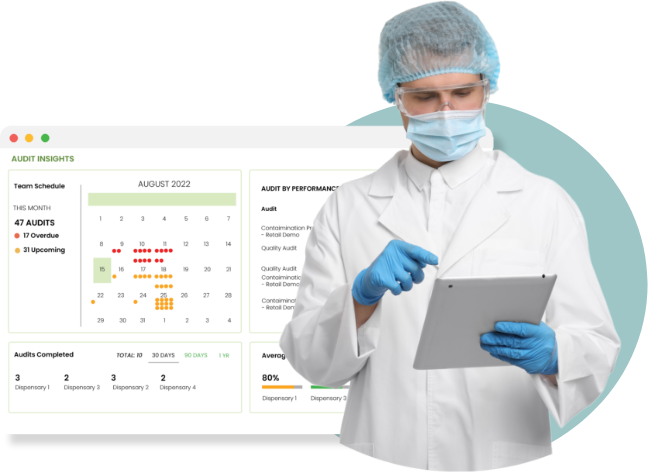Author: Ben Hartman | November 20, 2025 | 5 Min Read
Practical, Trackable Training: A Key Investment for Audit Success and Risk Management

In the food manufacturing industry, few things have a better return on investment than risk mitigation. And few things can be more costly than food safety incidents.
In 2018 alone, the economic burden of foodborne pathogens in medical care and lost wages accounted for around $17.6 billion, according to the USDA’s Economic Research Service. But that figure pales in comparison to those in a 2015 study that estimated that the national cost of foodborne illnesses reached at least $55.5 billion.
But even just on the individual company level, the costs can be enormous. According to an oft-cited study published by the Grocery Manufacturers Association in 2012, the average cost of a food safety recall is no less than $10 million. To put it more simply, while comprehensive safety training may run costs into the thousands, the alternative can be far more costly.
Reducing the likelihood of foodborne contamination requires the building of a strong food safety culture, defined by the Global Food Safety Institute as “shared values, beliefs and norms that affect mindset and behaviour toward food safety in, across and throughout an organization.”
On the production floor, this means frontline workers know their roles and are constantly reinforcing them in daily operations. It also means they feel empowered to speak up when they see safety shortcomings or ways to make processes more effective and efficient.
In the same position paper (“A Culture of Food Safety), the GFSI wrote that “training and education are essential tools. It is vital to determine how well people both understand and have confidence in the training and education they receive. Only through complete comprehension and confidence are they likely to implement safe food behaviors and influence others around them to do otherwise.”
The ROI of Food Safety Training
Accidents can happen at any workplace, but effective, trackable training can dramatically reduce the odds of work stoppages and costly food safety incidents.
Industry studies have shown that effective training can reduce contamination risk by up to 80%, and effective training programs “teach employees to identify hazards, maintain hygiene, and follow protocols like proper cooking temperatures and cross-contamination prevention.”
The ROI of Customizable, Relevant Training
To maximize the ROI of safety training, it must be relevant to the everyday hazards and challenges that a company’s employees face.
A 2020 systematic review analyzed 31 studies and found that training “cannot just be translated into desired changes in attitudes and practices.” Instead, the training "should be relevant to the situation, promote active learning, increase risk perception, and consider the work environment.”
In other words, food safety training should not be a “one-size-fits-all” proposition. Instead, it should be customized to meet the unique food safety hazards posed by the workplace. This creates training that is more relevant to the learners and is thus more likely to be retained. Better training retention not only means that employees are more likely to remember their safety obligations, it also means that the company does not have to continuously spend more and more money retraining employees in subjects they should have already mastered.
Management should also consider investing in hands-on training that includes simulation of workplace hazards, which one 2021 study showed can boost employee training retention by 40%.
The ROI of Trackable Training
Money spent on food safety training can be largely in vain if the training is not trackable or properly recorded.
In a recent interview with Rootwurks, Andrea N. Griffiths, Retail and Supplier Audit Program Manager at ASI, spoke about the key role that recordkeeping plays not only in training but also in safety and recall prevention.
“Your recordkeeping is the most important aspect…if you don’t have documents, you have nothing. You lose all your traceability.”
This is why food manufacturers must switch to digital training systems. With trackable training, management can ensure that each individual employee has received the training they need for their particular role. It can mean less time and money wasted by training that is unnecessarily repeated or given to an employee who doesn't need it for their particular role.
Trackable training also means that companies have the ability to verify and validate employee comprehension of key safety guidelines, and are prepared to follow them when it counts.
Proper recordkeeping also has a strong ROI when it comes to compliance, where the lack of documentation itself can count as a critical non-conformity.
During a compliance audit, recordkeeping helps a company prove it has performed the mandated training, but the ROI can go even further. If a compliance non-conformity is found, auditors may ask to see if the company performed the necessary training for the issue in question before deciding the scope of the fine or corrective actions needed.
These documentation procedures are part of the overall recordkeeping that is essential for helping companies rapidly respond to contamination and food safety events, helping mitigate the damage - and the cost - in real time.
The ROI of Rapid, Effective Onboarding
The first training a company gives an employee occurs during onboarding, and it can have a major impact on employee development and retention. Studies have proven that effective longboarding increases not only employee productivity but also helps companies retain new hires.
When developing onboarding programs, companies must invest in training that is relevant to the new hire’s specific role and doesn’t overload them with information that they don’t need to hit the ground running.
The onboarding training must also be designed with the makeup of the company’s workforce in mind. If the staff is heavily Spanish-speaking, then bilingual training should be developed to ensure nothing gets lost in translation.
The Rootwurks LMS: Ditch the Pen and Paper and Boost Your ROI on Training
For trackable, effective food safety training, an analog system based on pen, paper, and an occasional video won’t get the job done.
With the Rootwurks learning management system (LMS), companies can build custom, trackable learning that integrates with in-house training materials and verify and validate employee retention and comprehension in real time.
New features deployed within the LMS include a voiceover synthesizer to build custom narration for training videos in more than 20 languages in a matter of seconds, a free food safety assessment tool, and “launch and learn” printable QR codes that instantly launch courseware, log in learners, and measure training effectiveness and progress in real time.
With the Rootwurks LMS, companies can maximize every dollar spent on training and build a culture of safety and risk mitigation that helps them avoid the high costs of food safety incidents.
To learn more, reach out to the Rootwurks team, and we’ll schedule a custom tour of our LMS.
Contributors

Ben Hartman
From HACCP certification to the basics of hygiene, our on-demand courseware has you covered.




.jpg?width=120&height=80&name=Baby%20(1).jpg)






